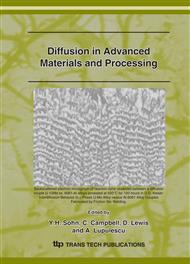p.83
p.101
p.109
p.119
p.131
p.149
p.157
p.171
p.181
Interdiffusion Behavior in γ-Phase U-Mo Alloy versus Al-6061 Alloy Couples Fabricated by Friction Stir Welding
Abstract:
To better understand interactions between fuel and cladding in research reactor fuels, diffusion couples between γ-phase U-7 wt% Mo and U-10 wt% Mo alloy fuels and a Si-bearing, Al alloy were fabricated using a friction stir welding technique. The advantage of such a fabrication technique is that it can potentially reduce the amount of aluminum-oxide that might be present at the diffusion couple interface. The presence of oxides at the interface can affect the interdiffusion process. These couples were annealed and characterized using a scanning electron microscope equipped with energy-dispersive and wavelength-dispersive spectrometers. Images were taken of the developed diffusion structures; x-ray maps were generated to identify partitioning behavior of the various components; and, point-to-point analysis was employed to generate composition profiles and to determine phase compositions. To try and determine how the presence of Si in an Al alloy affects the interdiffusion behavior of fuel and cladding components in research reactor nuclear fuels, the results from this study were compared to those from earlier diffusion studies using U-Mo alloys and Al. The formed diffusion zones in some samples annealed for 30 minutes are comprised of Si-rich aluminide phases that appear to be (U,Mo)0.9(Al,Si)4 and (U,Mo)(Si,Al)2, based on composition. The diffusion rates observed and the types of phases that form can be correlated to the stability of the γ-U phase, which is a metastable phase. For a sample annealed for a much longer time, large diffusion structures formed and no Si-rich phases were observed.
Info:
Periodical:
Pages:
131-148
Citation:
Online since:
September 2007
Authors:
Keywords:
Price:
Сopyright:
© 2007 Trans Tech Publications Ltd. All Rights Reserved
Share:
Citation:


